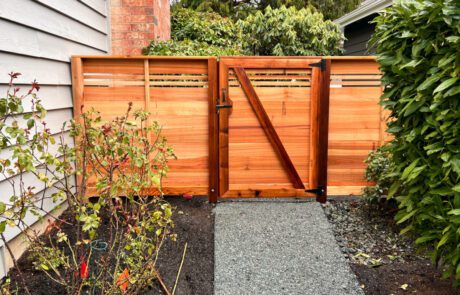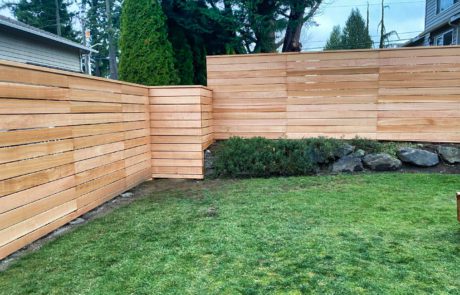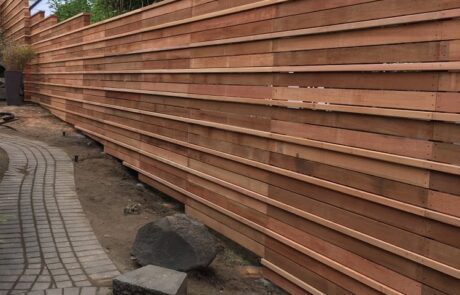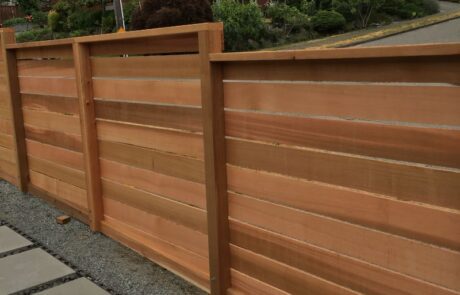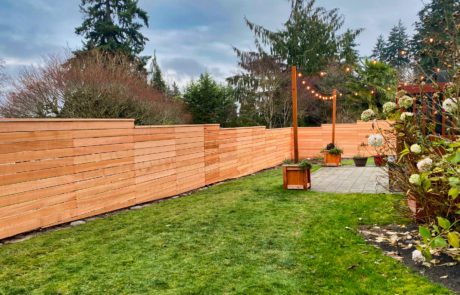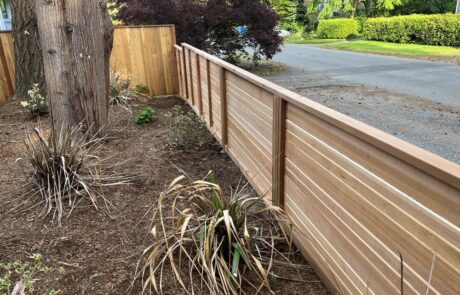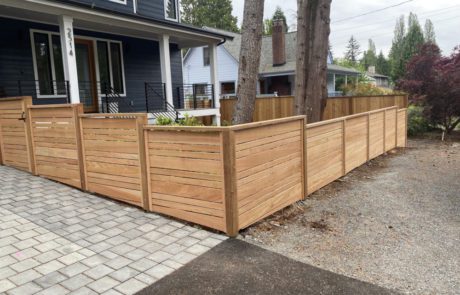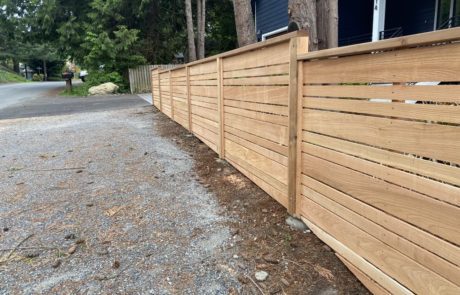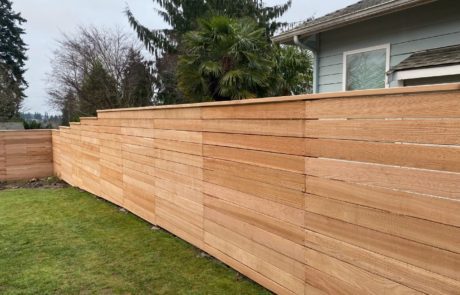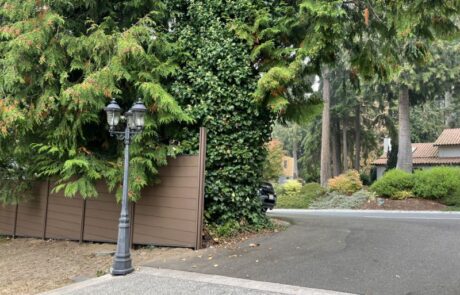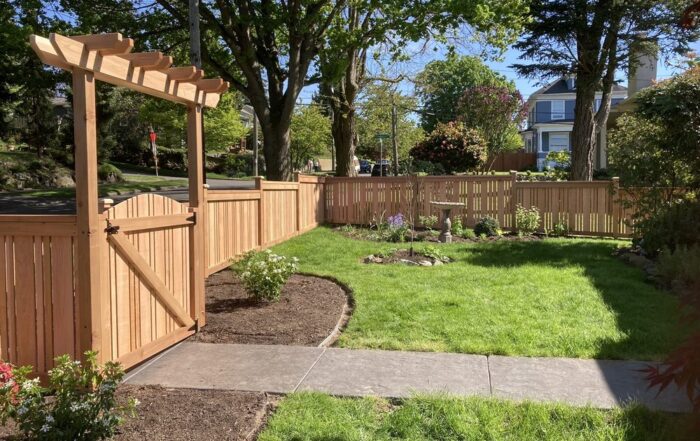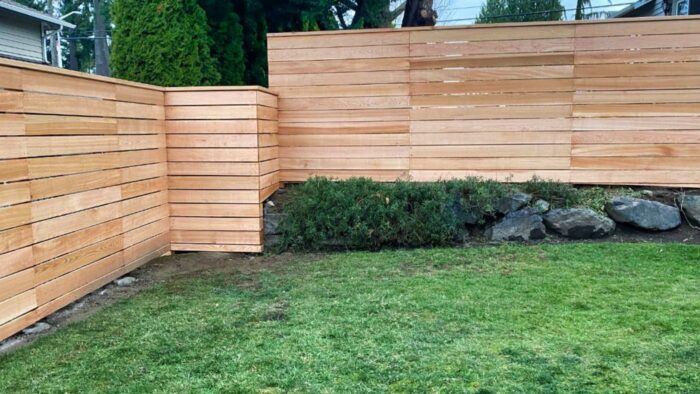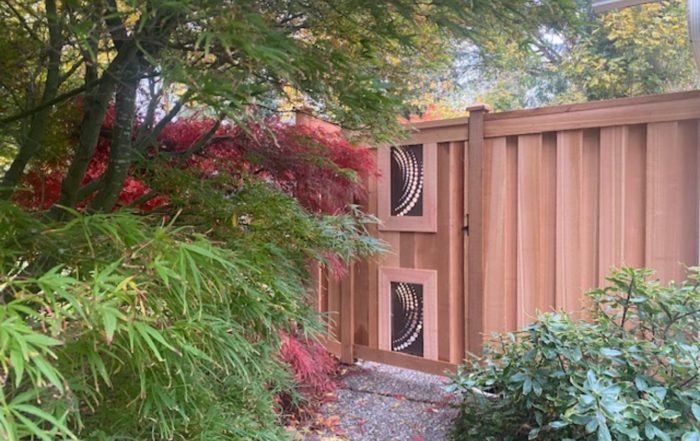Find out which fence style—horizontal or vertical—suits your home’s aesthetics and functional needs.
Listen: Expert Insights on Horizontal vs. Vertical Fences
Struggling to choose between a horizontal or vertical fence?
This comparison addresses critical aspects like aesthetics, installation costs, land adaptability, and privacy to streamline your decision. Find out which fence orientation could be the perfect match for your property.
Key Takeaways
- Horizontal fences offer a modern aesthetic with a variety of design options and materials, while vertical fences provide a classic look and can be more cost-effective and suitable for uneven terrains.
- While horizontal fences may require higher-grade lumber and closer post spacing for stability, vertical fences can offer better privacy with closer board placement and are easier to install on sloping land.
- Maintenance is key for both horizontal and vertical fences; horizontal structures might need more frequent inspections for alignment, whereas vertical fences require careful checking for rot, and both benefit from treatments to protect against weather.
Understanding Horizontal and Vertical Fences
A fence frames your outdoor living space, influencing your home’s curb appeal, privacy, and security. There are two primary types of fences that homeowners gravitate towards: horizontal and vertical. A horizontal fence consists of horizontal boards, crafted from a variety of materials like wood, vinyl, or metal, giving it a modern appearance. On the flip side, a vertical fence follows a more traditional design, with its boards running vertically from the ground up.
The orientation of the fence boards plays a significant role in defining the look and feel of your property. Horizontal fences, for example, tend to make a property appear larger by visually elongating the space. They come in a variety of design styles, such as woven wood, louvered, and shadow box, providing an array of aesthetic choices for homeowners.
On the other hand, vertical fences, such as the classic white picket fence or the sturdy wooden fence, offer a traditional look that suits many home styles. Regardless of the orientation, durability is a key consideration. Fences crafted from cedar, redwood, or pressure-treated lumber offer natural decay and rot resistance, while others, like pine, require chemical treatments to achieve similar durability. Steel posts are a great alternative to wood as they are less prone to decay and can be concealed with wood pickets to maintain the fence’s visual appeal.
Regardless of being horizontal or vertical, the fence board ends’ exposure to weather affects the rate of deterioration. However, horizontal fences may deteriorate more slowly. But don’t worry, practices such as minimizing ground contact and waiting several months before painting or staining new installations can prevent moisture-related damage and ensure your fence’s structural integrity.
Benefits of Horizontal Fences
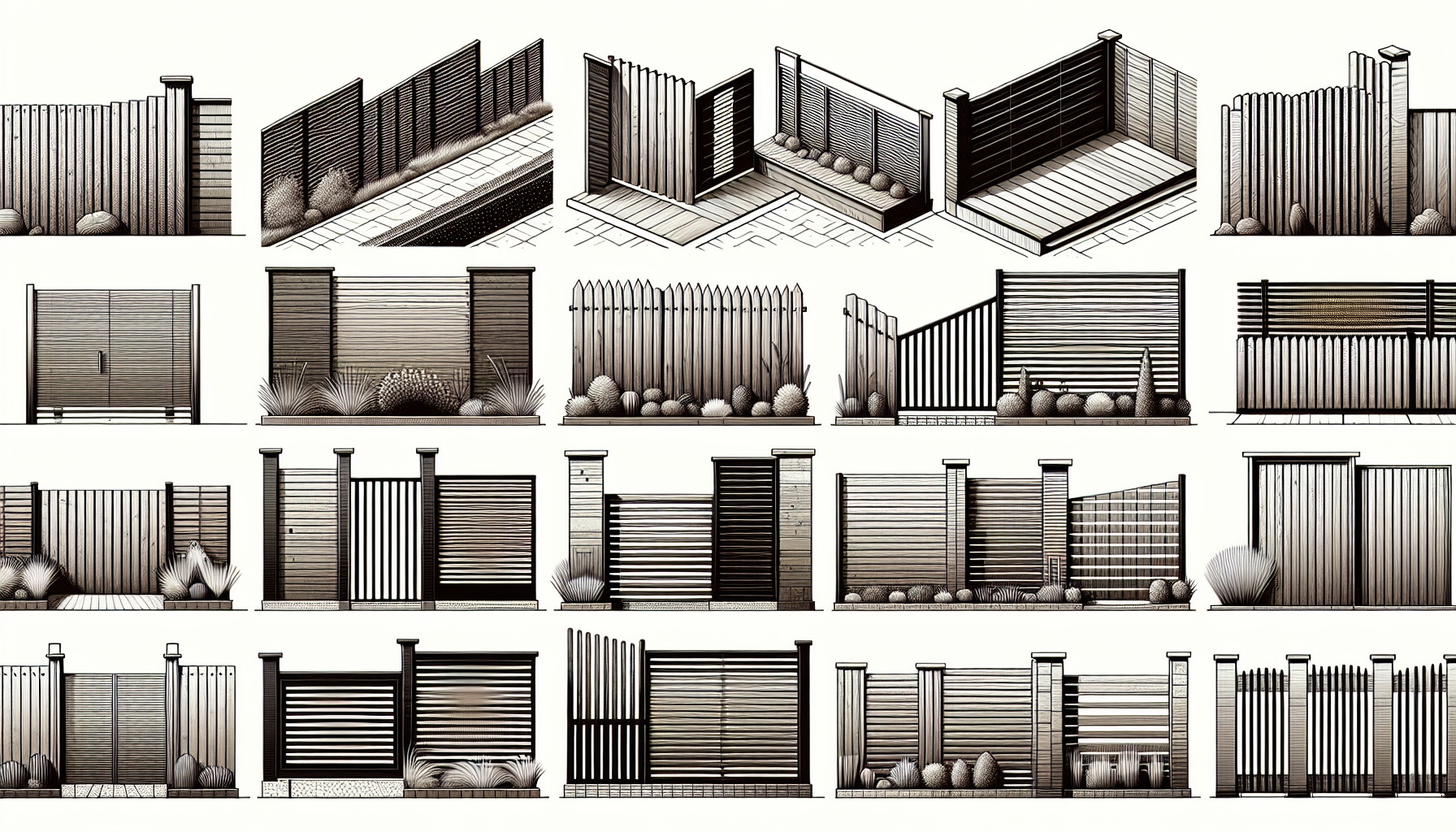
Horizontal fences, often featuring horizontal slats, provide numerous benefits for your outdoor space, including a modern aesthetic, versatile horizontal fence design options, and notable strength and durability.
Let’s examine these benefits more closely.
Aesthetic Appeal
The aesthetic allure of horizontal fences is undeniable. With their clean lines and seamless integration, they perfectly complement modern architectural styles, making them a popular choice for contemporary homes. The sleek, modern, and unique look of horizontal fences can significantly enhance a home’s curb appeal.
However, it’s not only about the shape. The materials used in constructing horizontal fences add to their visual interest. Some options include:
- Aluminum, which provides a weather-resistant option
- Cedar, which is often used for its natural beauty and property demarcation capabilities
- Louvered and woven wood designs, which further enhance the adaptability of fence aesthetics, allowing for a range of appealing designs.
Versatility
In terms of versatility, horizontal fences, including pallet fence options, stand out. They offer a broad array of finishes, from the warmth of natural wood to the sleekness of stains or the bold statement of paint, allowing for significant customization to fit individual property needs. The design options are diverse, including everything from full horizontal privacy fence to semi-private ones with spaced planks to contemporary designs featuring staggered or aligned seams and varied plank widths.
If you’re looking for a polished or rustic appeal, you can choose between smooth or rough lumber. For a unique touch, you can opt for mixed materials like wood with metal or stone. Want something low maintenance? Consider durable materials such as vinyl. With horizontal fences, the possibilities are only limited by your imagination.
Strength and Durability
In terms of strength and durability, horizontal fences are impressive. They’re built with a higher grade of lumber than vertical fences to ensure sufficient support and prevent sagging. The posts for horizontal fences are typically set closer together, about six feet apart, with rails carefully placed at the top and bottom to add extra durability and structural integrity.
While horizontal fences might be more susceptible to weathering, high-quality materials and design factors, like covered picket ends and optional metal frame reinforcements, mitigate the weathering impact. Furthermore, maintaining the strength of horizontal fences involves using tongue-and-groove planking for a snug fit and frequent maintenance.
Benefits of Vertical Fences
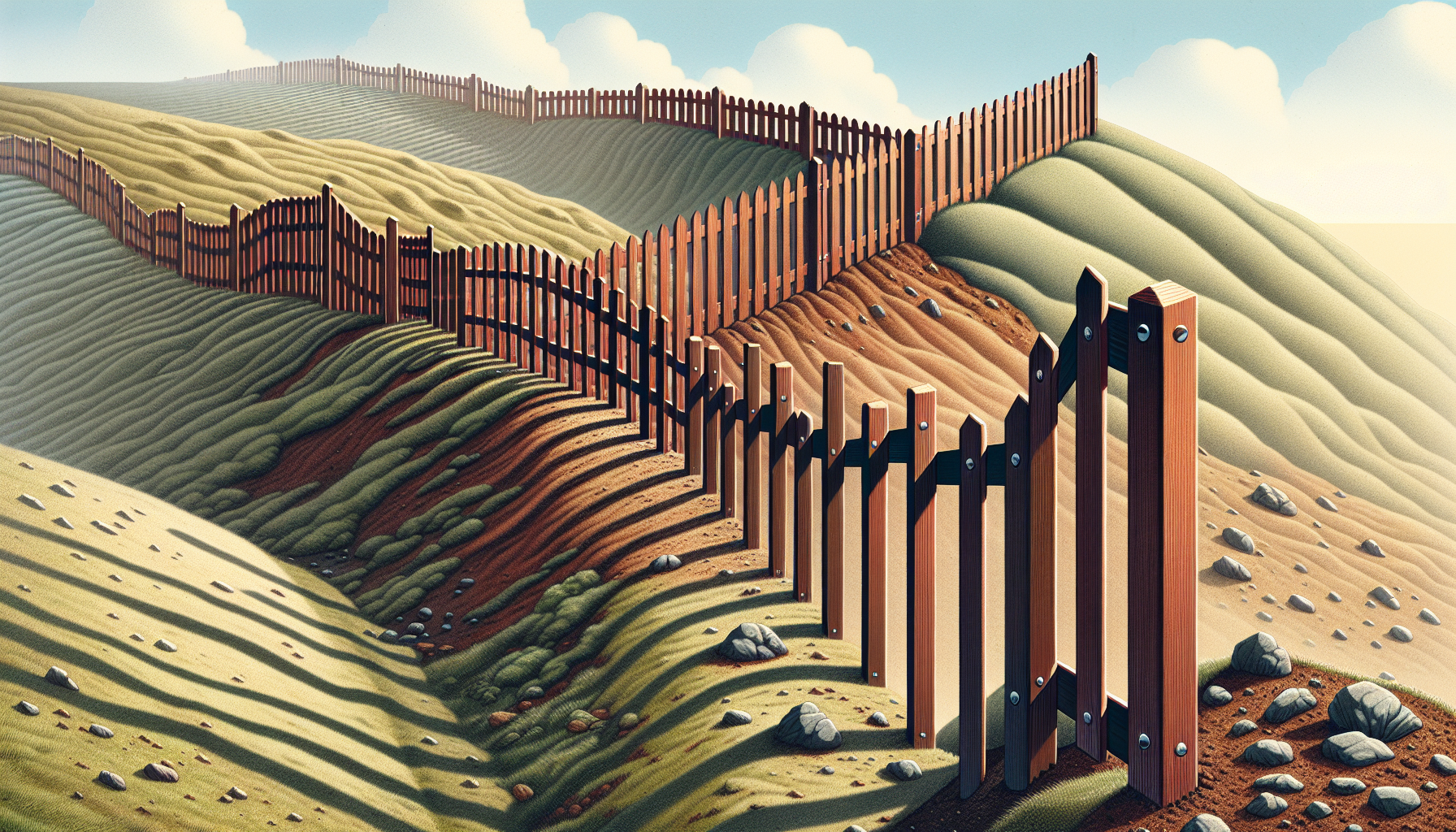
Although horizontal fences possess many advantages, vertical fences also boast a distinctive set of benefits. They are cost-effective, suitable for uneven terrain, and provide better privacy and security.
Let’s scrutinize these benefits further.
Cost-Effectiveness
To begin, vertical fences are more economical. They generally use less expensive materials like pine and cedar, supported by horizontal stringers for strength. The installation process is also more efficient and less expensive due to the availability of pre-made panels, which simplifies the process and can reduce labor costs.
In contrast, horizontal fences often require more expensive hardwoods like Ipe and Mangaris, making vertical fences a budget-friendly alternative. Furthermore, the DIY fence project of a horizontal wood fence with wooden panels can be a cost-effective option for those looking to save on labor costs.
Suitability for Uneven Terrain
Another key benefit of vertical fences is their adaptability to uneven terrain. They can be staggered or stair-stepped to conform to sloped terrains, providing flexibility and consistency in appearance. The design of vertical fences allows them to follow the contours of sloped ground smoothly, maintaining uniformity along the fence line.
If your property has significant slopes or uneven surfaces, vertical fences are the preferred choice. Horizontal fences, on the other hand, require relatively level ground for installation.
Privacy and Security
Due to their design, vertical fences provide enhanced privacy and security, similar to a privacy fence. The boards are closer together, making it difficult to climb and less easy to peer through, adding a level of privacy not typically found in horizontal fences.
By acting as a deterrent to potential intruders, vertical fences contribute to security, creating a safer home environment. They meet homeowners’ requirements for a fence that is secure, allows sunlight, and maintains aesthetic appeal, making them an excellent choice for those prioritizing privacy and security.
Factors to Consider When Choosing a Fence
Although we’ve considered the benefits of both horizontal and vertical fences, the final choice hinges on your specific needs and preferences. Let’s reflect on some pivotal factors that can sway your decision.
Budget
When choosing a fence, your budget should be one of your primary considerations. This includes not only the cost of the materials but also the cost of installation. As previously discussed, vertical fences tend to be more cost-effective, using less expensive materials and offering a more efficient assembly process.
However, it’s important to consider the projected lifespan of the fence. Investing more upfront in a durable fence can save on long-term replacement or maintenance costs. You’ll also want to avoid compromising on the grade and height of the fence materials for cost reasons, as a shorter or lower-grade material may not provide the desired level of privacy or durability.
Aesthetics
Second, you should not neglect the fence’s aesthetic appeal. A fence should add curb appeal and complement your home’s architectural style. For instance, horizontal fences are often preferred for modern architectural home styles, while vertical fences offer a more traditional look.
The color and texture of the fence should also be chosen to complement your existing landscaping and the exterior design of your home. Whether you prefer the classic look of wood, the low-maintenance appeal of vinyl, or the durability of metal, there’s a fence style out there that will meet your aesthetic preferences.
Landscape and Terrain
Finally, contemplate the landscape and terrain of your property. If your property has significant slopes or uneven surfaces, vertical fences are the preferred choice due to their ability to follow the contours of the land. On the other hand, horizontal fences might require additional installations, like retaining walls, to ensure stability on uneven terrains.
The landscape of your front yard also plays a role in the design of your fence. A well-chosen fence can enhance the design of your landscape, providing a harmonious backdrop that emphasizes the fence’s features and increases overall curb appeal. Strategic placement of hedges or shrubs can extend the privacy provided by a fence, offering both aesthetic and functional benefits.
Real-Life Examples of Horizontal and Vertical Fences
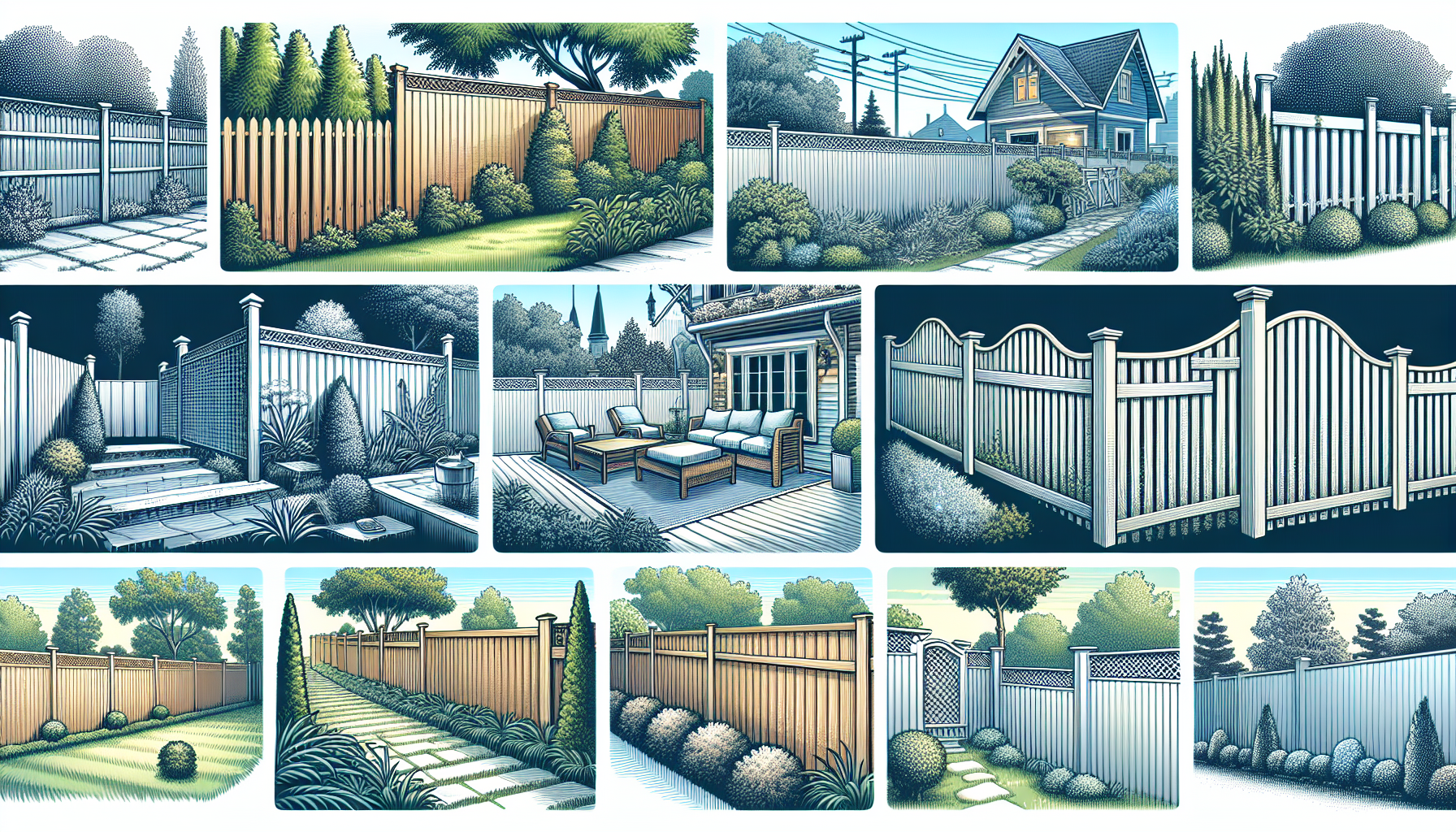
To illustrate these concepts, let’s examine some real-world examples of horizontal and vertical fences. These examples illustrate how horizontal and vertical fences can be utilized in different settings, showcasing their unique functionality and style.
For instance, Ipe, tigerwood, and cumaru are popular choices for horizontal fences due to their durability and natural beauty. Cedar, on the other hand, presents a more cost-effective softwood option, while cypress is specifically preferred in Florida for its resilience to the local climate.
An example of modern fence ideas includes the vertical fence design that combines cedar horizontal fence panels with a black metal fence border, blending traditional wood with contemporary metal accents and metal posts.
Maintenance Tips for Horizontal and Vertical Fences
Fence maintenance is vital for ensuring its longevity and structural integrity. Regular inspections, repairs, cleaning, and protective treatments can go a long way in preserving the look and health of your fence.
For horizontal fences, sealing the boards to avoid sagging and conducting regular inspections of the closely spaced posts to uphold stability and alignment is crucial. In contrast, vertical fences, having fewer posts, necessitate meticulous inspection for rot or instability. Panel-based repairs can be straightforward compared to the tailored maintenance needed for custom installations.
Summary
To wrap it all up, both horizontal and vertical fences have their unique advantages and can add value to your property. Horizontal fences offer a modern aesthetic, versatile design options, and enhanced strength, while vertical fences are cost-effective, adaptable to uneven terrain, and provide better privacy and security. Your choice should ultimately depend on your property’s landscape and terrain, your budget, and your personal aesthetic preferences. Regardless of the fence style you choose, regular maintenance can ensure your fence’s longevity and keep it looking great for years to come.
Frequently Asked Questions
Which is horizontal and vertical?
When looking at the terms “horizontal” and “vertical”, it’s important to note that a horizontal line goes side to side and is parallel to the x-axis, while a vertical line goes up and down and is parallel to the y-axis. It’s easy to remember that vertical goes up and down because the letter “v” points down.
Is it cheaper to build a fence horizontal or vertical?
It’s cheaper to build a vertical fence as it requires a lower grade of lumber and reduces the possibility of sagging compared to horizontal fences. Choose vertical for a more cost-effective option.
Which type of fence is suitable for uneven terrain?
Vertical fences are the most suitable for uneven terrain because they can closely follow the land contours, providing a more secure and visually appealing barrier.
How can I maintain my horizontal or vertical fence?
To maintain your horizontal or vertical fence, it’s important to conduct regular inspections, repairs, cleaning, and protective treatments to ensure its look and health. Regular maintenance will help extend the lifespan of your fence.
Which type of fence offers better privacy?
Vertical fences offer better privacy due to the close placement of their boards, making it difficult to climb or peer through. This makes them a great option for creating a private outdoor space.
A Few Examples of Horizontal Fence Options Available to Seattle Area Homeowners
Frequently Asked Questions About Horizontal Fences in Seattle
What type of wood do you recommend for a horizontal fence in Seattle?
We generally recommend cedar wood for its durability and natural resistance to the elements. Seattle’s weather can be quite variable, and cedar holds up well in our Pacific Northwest climate.
How long does a horizontal wooden fence typically last?
With regular maintenance and treatment, a cedar horizontal fence can last up to 30 years.
How often should I maintain my horizontal fence?
We suggest an annual check-up for your fence. Look for any signs of wear and tear, and apply a fresh coat of stain or paint every 2-3 years to keep it looking fresh and to protect against the elements.
Does a horizontal fence provide more privacy than a traditional vertical fence?
Yes, a horizontal fence can provide more privacy. The boards are typically installed without gaps, forming a solid barrier that’s harder to see through or climb over.
Will a horizontal wooden fence increase my property value?
Absolutely! A well-maintained and attractive horizontal fence can significantly increase the curb appeal of your home, which can in turn boost your property value.
How does a horizontal fence support local flora?
A horizontal fence acts as a supportive structure for climbing plants. You can create a beautiful living wall with local vines, adding a touch of greenery to your backyard and providing a habitat for local wildlife.
How is installing a horizontal fence an eco-friendly choice?
Opting for a wooden fence like cedar is an eco-friendly choice as it’s a renewable resource. Plus, wood has a lower carbon footprint compared to materials like plastic or metal. So, you can feel good about making a choice that’s kind to our planet.
We hope these answers have given you a better understanding of the benefits and considerations for installing a horizontal wooden fence in Seattle. If you have any additional questions or would like to get started on your project, contact us today! We look forward to helping bring your vision for outdoor living to life.

